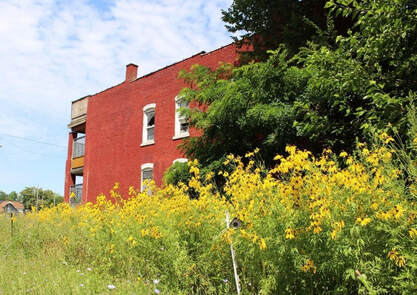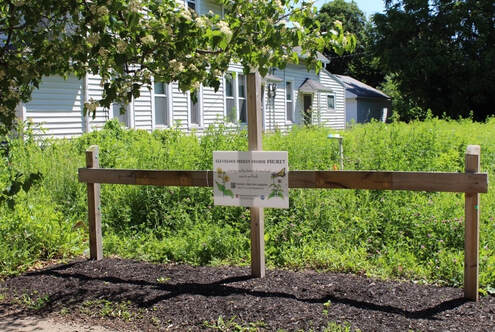|
written by: Maria Cramer, PhD student, Hamby Lab and Lindsay Barranco, MS student, vanEngelsdorp Lab When you conduct research on urban pollinators, it’s impossible to ignore the way your research impacts people and the way people impact your research. This was the overarching message from Dr. Mary Gardiner who studies the ecology of urban greenspaces in Cleveland, Ohio. Over the past several decades, Cleveland has lost half its residents, resulting from protracted economic decline. Currently, population levels equal what existed in Cleveland in 1900, resulting at least in part from a steady rise in home foreclosures. The home foreclosures and resulting vacant lots from demolished homes have led to a major increase in greenspace. The city of Cleveland maintains these lots by mowing on a monthly basis which costs the city upwards of 3 million dollars per year. Dr. Gardiner wondered if the weedy and grassy spaces within Cleveland’s 30,000 vacant lots could provide valuable bee habitat. Would planting flowering plants, exotic or native, provide better habitat than what the vacant lots offered? Which species of bees might these green spaces attract? And importantly, could providing bee habitat help beautify demolished and vacant areas? Leading up to her research that began in 2009, Dr. Gardiner worked with city representatives for over two years in order to lease forty vacant lots over a five-year period. Then she installed five different habitat treatments in each of eight city neighborhoods, turning the forty vacant lots into forty research plots. Her control treatment was simply the city’s current mowing approach. For comparison, she planted non-native “no mow” lawn lots, non-native flowering lawn lots, native grass lots, and “pocket prairie” lots composed of mixed native wildflower species. Gardiner chose the different treatments to see if they could be lower maintenance (the “no mow” lawn) or more attractive (the flowering lawn and “pocket prairie”) than the city’s standard approach. She also suspected that the “pocket prairies” composed of native wildflowers would support more of Ohio’s native bee species than the other treatments. Gardiner found that all of the lots hosted surprisingly large and diverse bee populations considering their size. They collected 107 mostly native species representing approximately 20% of Ohio’s total bee species. Ground nesting bees were found in all sites, ranging from 58-82% of the bees collected, which was exciting because they are thought to do poorly in urban environments due to a lack of places they can nest. Contrary to Gardiner’s expectation that some treatments would be better bee habitat than others, initial studies showed that bee communities do not differ among the habitat treatments. This may have been because pocket prairies mature slowly, and early sampling was conducted during these establishment years. Importantly, naturally occurring weedy vegetation was highly attractive to bees. Dr. Gardiner watched flowers and recorded which bees were visiting which flowers. She sampled almost 2,000 individual pollinator visits from 76 different bee species on 52 different plant species and found that weedy species such as red clover, chicory and Queen Anne’s lace tended to be the most important forage plants. Weed species were at least as important as flowers that were planted intentionally for pollinators. However, Dr. Gardiner suggested these results might change as the pocket prairies become established and start blooming. Overall, Dr. Gardiner found that bloom abundance – the abundance of flowers, not so much what the flowers were – was what really correlated with the number of bees collected. Dr. Gardiner has subsequently resampled each habitat following the full establishment of the pocket prairies and findings of those studies are being analyzed. Stay tuned for new results coming out of the project from summer 2019. At the landscape level, Gardiner found that large patches of continuous green space were an important driver of bee communities in vacant lots. Continuous green spaces supported native bee and wasp richness and bee reproduction. Gardiner suggested that maintaining connected patches of habitat could be a conservation initiative that shrinking cities could adopt; engaged city councils with community buy-in could use this information to consolidate vacant and lived-in properties. But action like this can only occur if politicians and community members are on board. This connects to a very different point Gardiner made throughout her talk—that performing research doesn’t happen in a vacuum. Better outcomes come from thinking about how community members engage in the project. Because she was establishing her plots in the middle of neighborhoods, essentially in people’s backyards, Gardiner approached her research plots differently from how a researcher at a research farm might. She incorporated the findings of Dr. Joan Irene Nassauer who investigates public perception of landscapes. According to Nassauer, landscape appearance serves to communicate between people and landscapes are seen as a reflection of the people who create them. Especially in urban areas, people view public shared spaces as reflections of themselves. While people who are already educated about the ecological benefits of natural landscapes view them positively, it’s easy for someone who doesn’t know about their function to see them as messy and uncared for. Nassauer lists “cues of care” that signal that a landscape is maintained, including mowing, linear design patterns, and fencing. Gardiner adopted all of these, regularly mowing her plots in clean lines, mulching, and putting up fencing. She also made signs to communicate about the function of habitat treatments. Throughout her talk Gardiner emphasized that there is an intrinsic connection between the people and the landscape in urban pollinator research. While her work centered around understanding what habitats could impact pollinators in cities, she also drove home the importance of design in order to be successful. Further, Gardiner suggested that effective implementation of any urban conservation initiative should involve carefully considering what message each landscape modification will send. Further Reading: Nassauer, Joan Iverson. “Messy ecosystems, orderly frames.” Landscape Journal 14 (1995): 161-169. Nassauer, Joan Iverson, and Julia Raskin. "Urban vacancy and land use legacies: A frontier for urban ecological research, design, and planning." Landscape and Urban Planning 125 (2014): 245-253. Turo, Katherine J., and Mary M. Gardiner. "From potential to practical: conserving bees in urban public green spaces." Frontiers in Ecology and the Environment 17.3 (2019): 167-175. Biographies: Maria Cramer is a PhD student in the Hamby Lab studying non-target effects of pyrethroid insecticides and RNAi in field corn. Lindsay Barranco is a MS student in the vanEngelsdorp Lab studying native bee abundance, diversity and nesting preference within small scale wildflower meadows. Comments are closed.
|
Categories
All
Archives
June 2024
|
Department of Entomology
University of Maryland
4112 Plant Sciences Building
College Park, MD 20742-4454
USA
Telephone: 301.405.3911
Fax: 301.314.9290
University of Maryland
4112 Plant Sciences Building
College Park, MD 20742-4454
USA
Telephone: 301.405.3911
Fax: 301.314.9290



 RSS Feed
RSS Feed




